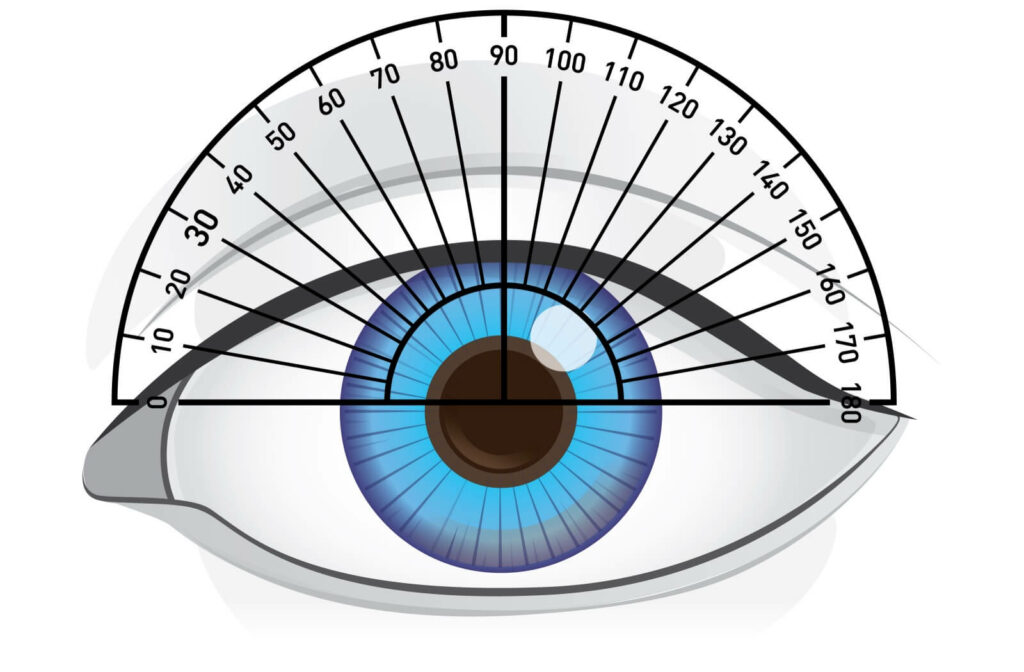Astigmatism is a common vision condition. Although it does cause blurry vision, it’s not typically a condition that needs to make you worried. Simply put, astigmatism occurs when the eye’s cornea or lens has an irregular shape, causing light to bend unevenly and resulting in blurred or distorted vision at all distances. It can be corrected with glasses, contact lenses, and laser eye surgery.
To help make this clearer, think of the difference between a basketball and a football. A normal eye has a round cornea like a basketball, allowing light to focus evenly across all points. However, with astigmatism, the cornea or lens is shaped more like a football, making light bend differently depending on where it hits the eye.
Astigmatism can be detected during your routine comprehensive eye exams. During those visits, we can also help you decide which option is best for helping you see clearly based on your eye health and lifestyle.
Normal Vision vs. Astigmatism
Individuals with normal vision have corneas and lenses uniformly curved, allowing light to converge at a single point on the retina. This results in clear and sharp vision. However, for those with astigmatism, uneven curves in the cornea or lens scatter light, causing it to focus on 2 or more points, which can lead to blurry or distorted vision up close and far away.
Are You Born with Astigmatism?
Astigmatism can be present from birth, but many people develop it during childhood or as young adults. Its exact cause is not fully understood, and some people can even develop it later in life due to an injury or a complication from surgery.
Regular eye exams from an early age are essential to detect and manage astigmatism effectively. If you suspect your child might be experiencing vision issues, it’s best to consult an eye care professional.
Can You Cure Astigmatism?
Astigmatism cannot be permanently cured, but it can be effectively managed and corrected. Corrective options like prescription glasses and contact lenses and procedures like LASIK can help you see more clearly when you have astigmatism.
While these options do not eliminate the underlying cause of astigmatism, they can help reduce or eliminate its impact on your daily life.
For most individuals, astigmatism is a lifelong condition, but with the right management plan, it won’t interfere with your ability to see clearly and live normally.
Symptoms of Astigmatism
Common symptoms of astigmatism include:
- Blurry or distorted vision
- Eye strain or discomfort
- Frequent headaches
- Squinting
- Difficulty with night vision
If you notice these symptoms or suspect you might have astigmatism, you should visit an optometrist. Early diagnosis can help prevent unnecessary strain on your eyes and improve your overall quality of life.

Are There Different Types of Astigmatism?
Astigmatism can be categorized in several ways based on the type or location of irregularity in your eye. The 2 primary classifications are regular and irregular astigmatism, while another classification involves lenticular astigmatism, which occurs when the lens itself is affected.
Regular Astigmatism
This type of astigmatism occurs when your cornea has two different curvatures that are 90 degrees apart. It often occurs naturally and can easily be corrected with glasses, contact lenses, or refractive surgery.
Irregular Astigmatism
Irregular astigmatism is less common and can result from conditions like keratoconus, trauma, or previous eye surgery. Wth this type of astigmatism, the curvature in your cornea is uneven and doesn’t follow a predictable pattern, making it harder to correct with traditional eyeglasses or lenses. Special lenses may be necessary to help you see clearly.
Lenticular Astigmatism
Lenticular astigmatism occurs when the irregularity lies in the lens instead of the cornea. This type is less common and may result from changes in the eye due to aging or cataracts.
How Is Astigmatism Corrected?
The options for correcting astigmatism include:
Prescription Glasses
Most regular astigmatism cases can be corrected with eyeglasses that contain a special prescription to counteract the curvature of your eyes.
Contact Lenses
Rigid gas-permeable (RGP) contact lenses are particularly effective for more pronounced cases of astigmatism, as these hard lenses can retain their shape while sitting on the eye’s surface. For less severe cases, soft toric lenses designed for astigmatism are often recommended.
Refractive Surgery (LASIK or PRK)
Laser procedures like LASIK and PRK reshape the cornea to eliminate uneven curvature, providing dramatic correction for astigmatism. While these procedures may significantly reduce your need for glasses or contacts, they do not always eliminate the need for corrective lenses entirely.
Astigmatism in Children
Astigmatism is common in children and often goes unnoticed until they have an eye exam. If untreated, it could impact their ability to learn and perform in school due to poor vision. That’s why scheduling regular eye exams is so important. Early treatment can ensure your child’s vision develops correctly, reducing potential issues later in life.
Let’s Talk About Astigmatism
While astigmatism is a manageable condition, it can impair your vision if left unaddressed. If you’re experiencing symptoms or have concerns about your sight, contact us to schedule an eye exam.
At Total Focus Optometry, we can assess your vision and provide personalized solutions tailored just for you. Whether it’s glasses, contact lenses, or guidance for surgical options, we can help you achieve clear and comfortable vision. Book your appointment today to get started.




